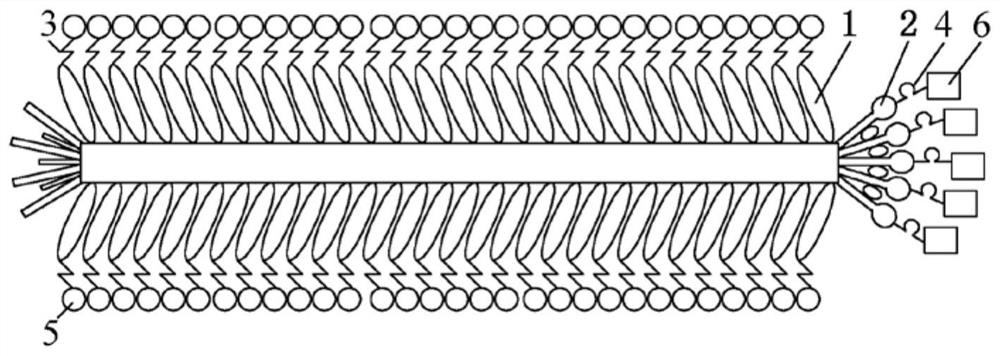A preparation method of composite photocatalytic material based on microbial template
A technology for composite photocatalysis and photocatalytic materials, which is applied in the field of composite photocatalytic material preparation based on microbial templates, can solve the coupling and synergistic effect of difficult composite photocatalytic materials, and it is difficult to realize zinc oxide-cadmium sulfide semiconductor heterojunction gold nanoparticles Problems such as nanoscale controllability of large and small loading sites, and difficulty in obtaining large-scale nanomaterials
- Summary
- Abstract
- Description
- Claims
- Application Information
AI Technical Summary
Problems solved by technology
Method used
Image
Examples
Embodiment 1
[0027] In this example, titanium dioxide is used as the photocatalytic material 5, Au is used as the catalytic loading material I6, and M13 phage is used as the biological template. The structure of M13 phage is as follows: figure 1 shown. The specific preparation process of the composite photocatalytic material is as follows:
[0028] 1) Use phage display technology to screen the polypeptide Ⅰ3 with specific adsorption and nucleation ability to the photocatalytic material titanium dioxide 5 and the polypeptide Ⅱ4 with specific adsorption and nucleation ability to the catalytic loading material ⅠAu6;
[0029] 2) Using genetic modification technology to express the polypeptide I3 with specific adsorption and nucleation ability on PⅧ protein 1 of M13 phage, and express the polypeptide II4 with specific adsorption and nucleation ability on PⅢ protein 2 of M13 phage, Its structure is as figure 2 shown;
[0030] 3) The concentration of 25mL genetic modification is 5×10 13 Pfu / ...
Embodiment 2
[0033] In this example, titanium dioxide is used as the photocatalytic material 5, Au is used as the catalytic supporting material I6, cadmium sulfide is used as the catalytic supporting material II8, and M13 phage is used as the biological template. The structure of M13 phage is as follows: figure 1 shown. The specific preparation process of the composite photocatalytic material is as follows:
[0034] 1) Use phage display technology to screen the polypeptide Ⅰ3 with specific adsorption and nucleation ability to the photocatalytic material titanium dioxide 5, the polypeptide Ⅱ4 with specific adsorption and nucleation ability to the catalytic loading material ⅠAu6, and the sulfidation of the catalytic loading material Ⅱ Cadmium 8 is a peptide III7 with specific adsorption and nucleation capabilities;
[0035] 2) Using genetic modification technology to express polypeptide I3 and polypeptide III7 with specific adsorption and nucleation ability on PⅧ protein 1 at different posi...
PUM
 Login to View More
Login to View More Abstract
Description
Claims
Application Information
 Login to View More
Login to View More - R&D
- Intellectual Property
- Life Sciences
- Materials
- Tech Scout
- Unparalleled Data Quality
- Higher Quality Content
- 60% Fewer Hallucinations
Browse by: Latest US Patents, China's latest patents, Technical Efficacy Thesaurus, Application Domain, Technology Topic, Popular Technical Reports.
© 2025 PatSnap. All rights reserved.Legal|Privacy policy|Modern Slavery Act Transparency Statement|Sitemap|About US| Contact US: help@patsnap.com



